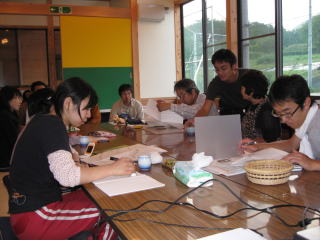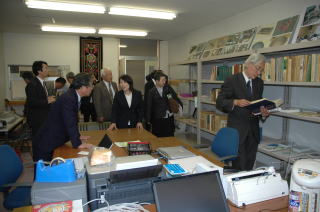 Our projects are going on!
Our projects are going on!  @ 2016.2.20
@ 2016.2.20


Plants and People Museum
Kosuge Village, Yamanashi, JAPAN
 Our projects are going on!
Our projects are going on!  @ 2016.2.20
@ 2016.2.20



2016.2.15 Ethnobotanical Notes No.9.
The origin and dispersal of Indian millet and proso millet
2010.1.29
International symposium: Foods, agriculture, life and biodiversity
Conservation and revival of indigenous varieties
Case studies on the millet and vegetables in Japan
Mikio KIMATA
Summary
The biodiversity has become more abundantly through the biological evolution on the earth since about 3.5 billions, but this long history was a process full of ups and downs. The whole biodiversity on the earth has been attacked by the catastrophes five times. Today the sixth severe catastrophe is the most important environmental issue for us, because it is clearly led by humankind and their modern civilization, but not by the natural process. The biodiversity consists of very complex relationships. Table 1 shows each biodiversity of the following levels, community, species, individuals and gene at the agro-ecosystem.
Recently, a concept of biocultural diversity is proposed, because the biodiversity, which had involved with cultural evolution, has been promoted by the history related organism with humankind on farmland since the beginning of agriculture (10,000 BP). This concept involves various traditional cultural matters from plant diversity (e.g. genetic variation) to techniques on the use, cultivation, processing, cooking, agricultural functions and table manner, as a basic agriculture complex, gfrom seed to stomachh (Nakao 1966), including all organism (wild and domesticated plants) related with humankind.
The conservation of plant biodiversity contains not only biological issues from ecosystem to gene, but also cultural issues. Moreover, we must conserve the written and visual information of biocultural diversity, while we do conserve the traditional knowledge of proud villagers who have lived at a farmland and rural community for the fundamentals of environmental learning. Everybody needs to learn the indigenous traditional knowledge of biocultural diversity. The rice paddy cultivation is so-called Japanese fundamentals, but the farmers had used wild plants and cultivated millet, wheat, barley etc. at upland fields in mountain villages.
We have practiced a project gPlants and People Museumh at the Ecomuseum Japan Village for learning conservation of biocultural diversity, in Kosyge-mura, Yamanashi prefecture, where is located very important forests for the drinking water reservation of Tokyo Metropolis. This project may propose a model for rural development with the conservation of biocultural diversity. We promote the conservation and revival of indigenous varieties of millet and vegetables with villagers. This concept is supported theoretically by our research on the traditional knowledge system of distinguished farmers in Japan and Eurasia. They have vividly told us their excellent experiences and indigenous knowledge.
We have reported the two projects in summer, 2007.
Environmental Education Studies:
Formation of Vernacular Names for Weeds and Plant Naming Programmes for the Re-creation of Childrenfs Culture
Mikio KIMATAC Miho NONOMURA and Yoshimi OSAWA
Field Studies
Institute for Environmental EducationC Tokyo Gakugei University
The formation of vernacular names was studied for the weed species of genus
RorippaC
Cruciferae. The linguistic mode and
meaning were compared among scientificC EnglishC and Japanese standard and vernacular
names. The scientificC
EnglishC and Japanese standard names were derived mainly from
morphological and ecological traits and place-namesC
while the vernacular names were uniquely formed by local farmers. The result obtained for that study provided crucial insight for the plant
naming programme discussed in this paper.
The plant naming programme was designed and applied twice to the activities of Dokodemo Museum Eco-Project and Nukui Agriculture School for Boys and Girls in 2004. The study involved mainly children from primary schools. These activities required them to name a plant on their own after observing them and their habitats in the fields. The names given by the participants had the structure of {adjective word + root + supplementary word} or consisted of unique words without any root. The root was mostly a word indicating a plant habit or organs such as herbsC flowersC seedsC leaves and so on. The adjective word often showed morphologicalC ecologicalC and sensuous traits or their composition. The supplementary word was rarely used when the participants hesitated to name a plant. At the same timeC they drew sketches of plants and searched for further information in illustrated plant dictionaries. After checkingC the Japanese standard and scientific names and reading commentsC it is possible that they might have understood that their names for plants were fair and sensible.
FirstC children form vernacular namesC then learn Japanese standard names and finally learn scientific names. This is a suitable way to learn about plants. In factC it was a very interesting activity for the modern children to name a plant on their own because children exhibited such behavior as part of their own culture all across Japan about 60 years ago. This plant naming programmes may be effective in re-creating of childrenfs culture which is have almost lost at the present time. FurtherC we need to develop a method to learn scientific names easily because they are common names across the world.
(Environmental Education 17(2): in press)
Home Garden Project supported by Tokyu Environment Foundation:
The Late Years of Millet Cultivation in Villages in Upper Reaches of the Tamagawa: Conservation for Biocultural Diversity in Connection with Traditional Upland Farming
@@Mikio Kimata, Hiroe Imura (Field Studies Institute for Environmental Education,
Tokyo Gakugei University);
Shoko Masuda (Rikyo University); Noriaki Inoue (High School, Ohtsuki College)
and Yuko Ishikawa (Kyoto University)
Abstract
We have conducted the research project on cultivation and utilization of millets at several villages in upper reaches of the Tamagawa since 1974. Through the participatory observation, it has been definitely shown that the villagers have strong home gardening traditions that serve as contexts for the conservation, exchange and transmission of traditional plant germplasm, indigenous knowledge and management techniques. However, the genetic erosion is occurred under a very serious condition, because few farmers cultivate the landraces of millets today. Our aim is to fundamentally, empirically, and specifically examine the following (1) the extent to which domestic gardens serve as conservation refuges for plant genetic resources, (2) the mechanisms by which gardeners develop new landraces and share and exchange germplasm and knowledge, and how this is transmitted over time and spatially, and (3) the biodiversity of landraces which is made from their genetic and environmental background.
This research will have two complementary and overlapping methodological foci: the first derived from ethnobotany, the second from environmental education studies. Using ethnobotanical methodology, we will establish database of composition, plant uses, garden size and individual gardener knowledge of plants, gardening techniques, and informal education system for transmission of traditional knowledge. That is fundamentally interdisciplinary, contributing to the emerging field of biocultural diversity studies as applied to home gardens and small-scale agriculture. The research is also timely in terms of public concern with genetic erosion and genetic modification. Academically, the project will pioneer the ethnobotanical study of home gardens in Japan and their role in situ genetic conservation, as well as developing new biocultural research paradigms